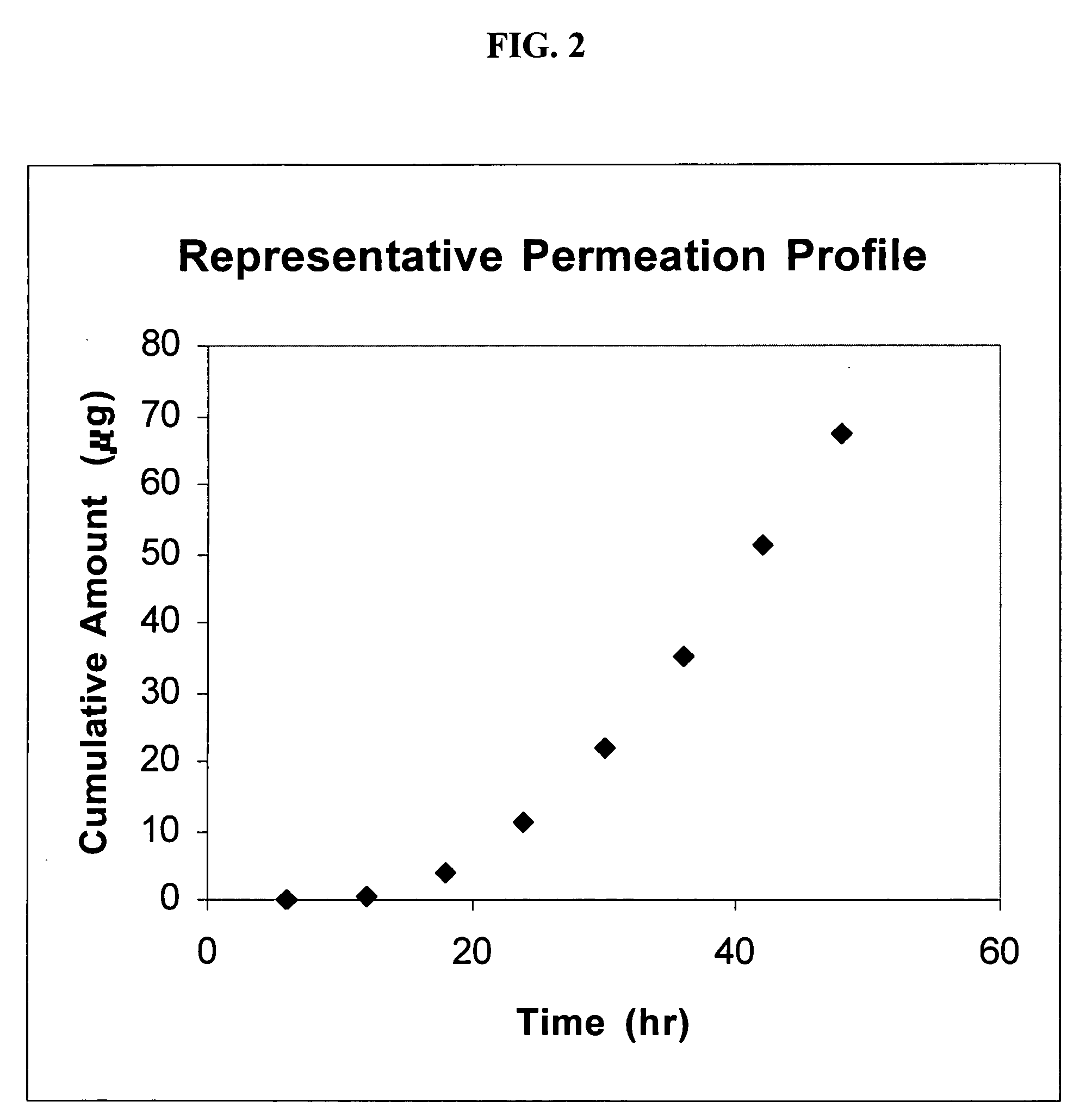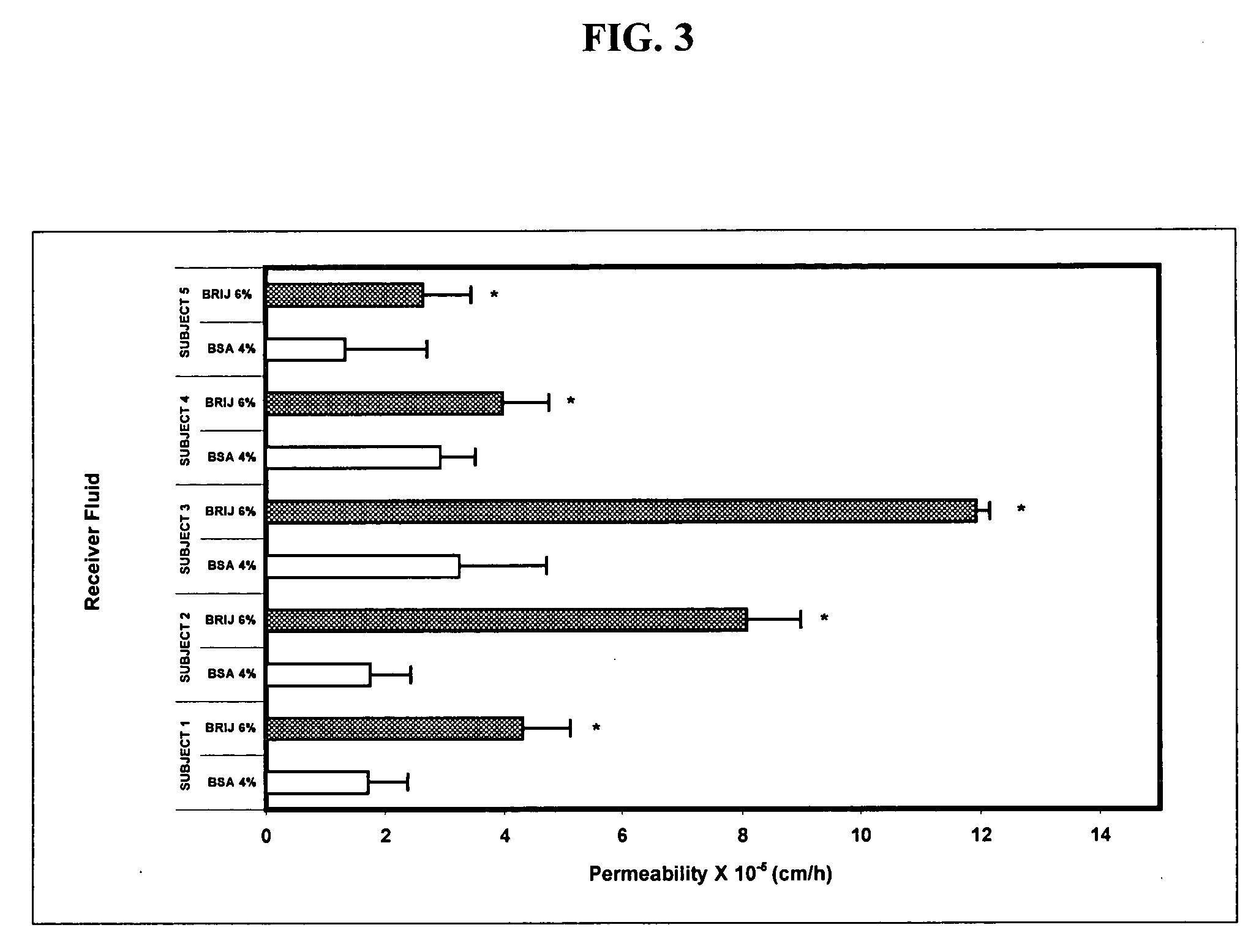Transdermal delivery of cannabinoids
- Summary
- Abstract
- Description
- Claims
- Application Information
AI Technical Summary
Benefits of technology
Problems solved by technology
Method used
Image
Examples
example 1
Delivery of WIN 55,212-2 Across Skin
[0076] WIN 55,212-2 Mesylate (melting point 244-245° C.) was purchased from Research Biochemicals International, Natick, Mass. Reagent-grade chemicals were used as received.
[0077] The skin permeation study was carried out using skin excised during abdominal reduction surgery. The skin sample was harvested from the abdomen using a Padgett dermatome set to 250 μm; the skin sample was frozen at −20° C. for one week. The frozen skin sample was thawed and used at the 250 μm split-thickness for the diffusion study. Three PermeGear In-Line Flow Cells were used for the skin permeation study. The receiver fluid was 6% BRIJ® 98 (Polyoxyethylene 20 Oleyl Ether), in order to increase the partitioning of this extremely lipophilic drug into the receiver. The receiver fluid was pumped through the diffusion cells at a rate of one milliliter per hour. The receiver samples were refrigerated until HPLC analysis. The temperature of the diffusion cells was maintaine...
example 2
Optimization of in vitro Experimental Conditions for Studying Permeation Through and Metabolism of Cannabinoids by Human Skin
[0083] The permeability of human skin has been studied for several decades. The skin consists of two major layers, the outer epidermis and the inner dermis. The stratum corneum (“SC”), the outermost 10-20 μm of the epidermis, is responsible for the skin's excellent diffusional resistance to the transdermal delivery of most drugs. Most of the skin's enzymatic activity lies in the basal cell layer of the viable epidermis. Fibrous collagen is the main structural component of the dermis. The skin vasculature is supported by this collagen and lies a few microns underneath the epidermis. Basically, it is here that permeation ends and systemic uptake begins. Many researchers have developed skin permeability relationships based on the physicochemical parameters (molecular weight, molecular volume, lipophilicity, hydrogen-bonding potentials, polarity, etc.) of skin pe...
example 3
Delivery of 2-[3-methyl-6-(1-methylethenyl)-2-cyclohexen-1-yl]-5-pentl-1,3-benzenediol Across Skin
[0107] The flux of 2-[3-methyl-6-(1-methylethenyl)-2-cyclohexen-1-yl]-5-pentyl-1,3-benzenediol (a cannabidiol) (“CBD”) across human skin was measured following the procedures set forth in Example 2, except that the donor compartment was charged with CBD in mineral oil (saturated) instead of Example 2's Δ9-tetrahydrocannabinol in propylene glycol (50 mg / mL). Two receiver solutions were employed: 4% BSA and 6% BRIJ® 98. The experiments were run as in Example 2, and the maximum flux was calculated. The results are presented in FIG. 8.
[0108] A number of compounds may be useful in enhancing the transdermal permeation of cannabinoids by increasing the amount of a co-administered cannabinoid within a patient's skin. Suitable permeation ehnancers include, for example, propylene glycol monolaurate, diethylene glycol monoethyl ether, oleoyl macrogolglycerides, caprylocaproyl macrogolglycerides,...
PUM
| Property | Measurement | Unit |
|---|---|---|
| Time | aaaaa | aaaaa |
| Flow rate | aaaaa | aaaaa |
| Viscosity | aaaaa | aaaaa |
Abstract
Description
Claims
Application Information
 Login to View More
Login to View More - R&D
- Intellectual Property
- Life Sciences
- Materials
- Tech Scout
- Unparalleled Data Quality
- Higher Quality Content
- 60% Fewer Hallucinations
Browse by: Latest US Patents, China's latest patents, Technical Efficacy Thesaurus, Application Domain, Technology Topic, Popular Technical Reports.
© 2025 PatSnap. All rights reserved.Legal|Privacy policy|Modern Slavery Act Transparency Statement|Sitemap|About US| Contact US: help@patsnap.com



